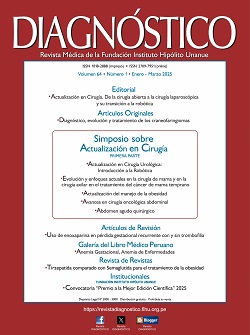Update on the Management of Obesity
DOI:
https://doi.org/10.33734/diagnostico.v64i1.573Keywords:
Obesity, bariatric, gastric bypass, sleeve gastrectomy, SADIS bypassAbstract
Obesity, recognized as a disease by the WHO in 1948, is chronic and multifactorial, affecting millions of people. It is
primarily diagnosed by a BMI over 30 kg/m², though this method has limitations. Its prevalence has tripled since 1975, with
genetic, socioeconomic, and environmental factors contributing to its development. Treatment includes lifestyle changes,
medications, and bariatric surgery, with recent advancements in pharmacotherapy showing favorable outcomes in weight loss
and cardiovascular risk reduction. Common procedures, such as Roux-en-Y gastric bypass and sleeve gastrectomy, have shown
sustained weight loss results, achieving 50-75% excess weight loss at 10 years. The SADIS bypass offers a low complication rate
and better outcomes, with more than 80% excess weight loss at 10 years. Each of these procedures has different remission rates for associated metabolic diseases. Selecting the appropriate procedure must balance effectiveness with patient safety. All of these operations allow discharge within the first 24-48 hours, with patients returning to work 5-7 days post-surgery.
Downloads
Metrics
Downloads
Published
How to Cite
Issue
Section
License
Copyright (c) 2025 Aurelio Barboza-Beraún

This work is licensed under a Creative Commons Attribution 4.0 International License.


























